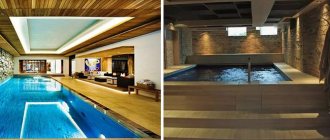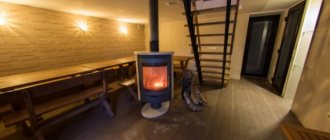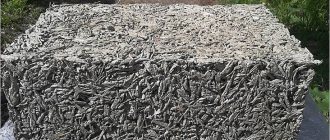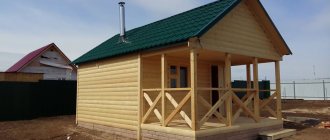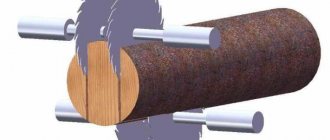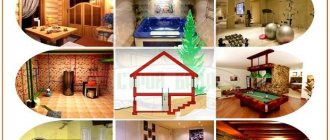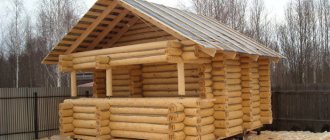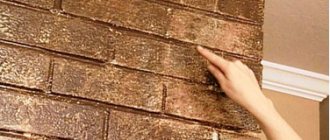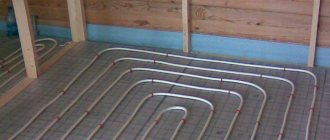Regardless of the size of the land plot and financial capabilities, each of us tries to make housing as convenient, comfortable, practical and multifunctional as possible. You can bring your plans to life by combining several types of structures into one large complex, for example, combining a house with a terrace, bathhouse, garage or veranda. Of course, this solution has both advantages and disadvantages, which we will discuss in this article.
Types of baths
Designs of bathhouses attached to the house differ depending on the type of steam room:
- Russian bathhouse with its classic attributes - a stone stove, wet steam, brooms and a font.
- Finnish sauna, in which, thanks to dry steam, you can stay in it even at a temperature of 100 degrees, but in this case the use of brooms is strictly prohibited, as they can lead to burns.
- Turkish hammam with an air temperature of about 60 degrees. You can spend a lot of time in such a steam room without harm to your health.
The choice of a bathhouse for construction depends on the personal preferences of the owner of the site.
Projects of houses with a sauna
Project of a small house with a sauna
For a small family, a house project with a basement floor, the total area of which is 364 square meters, is ideal. m. The area of the building itself is 145 sq. m. m, and the living area is 151 sq. m. m.
Project of a house with a sauna in the basement
The ground floor layout includes a vestibule that leads to a walk-in closet. Nearby there is a relaxation room, sauna, shower and gym.
Ground floor plan
The main entrance leads into a corridor, from where you can access the hallway, and from there - all the other rooms on the first floor.
First floor plan of the house
On the second floor there is a kitchen-dining room, three bedrooms, a living room and a bathroom. In the central part of the floor there is a hall that unites these rooms.
Second floor plan of the house
Project of a two-story house with a sauna
Project of a two-story house with a sauna and a garage
The layout of a two-story house with a sauna involves placing a sauna, a place to relax, a toilet and a shower on the ground floor.
On the second floor there is a kitchen, dining area, bedroom, and one utility room.
Project of a house with a sauna and a swimming pool
If you are going to build a three-story house, then on the ground floor it is advisable to place a room with an indoor pool with a sauna, from where there is additional access to the garden. On the second floor there are bathrooms and bedrooms, and on the top floor there is a living room, kitchen, and guest toilet.
Project of a house with a sauna and a swimming pool
It is advisable to have a bathroom in each bedroom. You can set up a barbecue on the terrace.
All concerns about arranging a sauna in the house are resolved by clear project planning and high-quality installation work.
How to install a bathhouse?
Is it possible to attach a bathhouse to the house? There are no legal restrictions; in addition, there are rules that regulate the construction of extensions of this type. There are several options for how you can combine a steam room with a living space:
- Using an existing wall of the house. This method is the most economical, since costs are reduced for the construction of one wall of the bathhouse. However, the savings will have to be invested in high-quality vapor barrier and waterproofing, as well as fire safety methods. It is especially important to comply with all fire safety rules if the house to which the steam room is attached is wooden.
- Bathhouse attachment to the house. In this case, the bathhouse attached to the house has its own wall, which is built close to the wall of the dwelling. The advantage of such construction is that there is no need to make a vapor barrier. In this case, the doorway connecting the two buildings turns out to be quite wide, so it makes sense to install two doors instead of one and make the one closer to the house fireproof.
- Connecting the house and the bathhouse with a short passage. In this situation, the bathhouse does not come into direct contact with the home, but it is easy to carry out all the necessary communications through the existing corridor.
The choice of method depends on the planned construction budget, personal preferences and the type of house to which the steam room is attached.
Construction of a sauna in the basement
When arranging a bathhouse in a basement or semi-basement, first of all you need to take care of wall insulation and waterproofing. The primary layer of expanded polystyrene and roofing felt are laid around the perimeter of the outer surface of the walls.
This is followed by the application of a coating waterproofing mastic inside the future bathhouse. After the insulation layer has dried, they proceed to installing load-bearing sheathing on the basement walls, which will hold the thermal insulation and lining of the bathhouse.
It can be made from a galvanized profile or wooden slats; wood can be used for sheathing in the basement without restrictions, provided it is impregnated with silicone fire-resistant varnishes or fire retardants.
In any case, there must be an air gap between the wall and the layer of mineral insulation. The ceilings and floors of the bathhouse are made in a similar way. The laid insulation is laid with a vapor barrier and sewn up with finishing material. OSB-3 boards, which have high strength and are resistant to water and open flame, are traditionally used as a rough covering in the basement.
Advantages and disadvantages
The pros and cons of a bathhouse attached to a house give a person the opportunity to think about his decision about future construction. The advantages include the following:
- the opportunity to visit your own steam room without leaving home;
- reduction in costs for a separate water supply, since communications are carried out from the house;
- there is no need to go outside and be exposed to sudden temperature changes during the cold season.
However, when trying to make a bathhouse attached to a house, a person may encounter the following number of difficulties:
- compliance with all SNiPs that regulate high-quality waterproofing, vapor barrier and fire safety standards;
- engineering communications require careful calculations, as in the case of self-construction;
- the need for regular treatment of premises with antiseptics.
The majority of the disadvantages are rather arbitrary, since when building a free-standing bathhouse one would have to comply with all the same established standards.
Features of installing windows and walls
If timber will be used in the construction of a bathhouse, you should calculate the possible shrinkage that will occur over the next few years. If you decide to use blocks or bricks, you should take care of perfectly smooth walls, which can only be achieved by complying with all the rules and requirements regarding masonry. If the bathhouse will act as an extension, then care should be taken to ensure the correct joining of the load-bearing walls in order to ensure the most optimal connection. You will need to drill several holes into which the reinforcing bars will be threaded. They are driven in so that their end is fixed in the masonry of the future building.
Of all the possible window designs, metal-plastic structures are the most popular. They are quite practical and easy to use. They require virtually no maintenance and have a long service life. When working with them, you should adhere to the following rules:
- each window should have a small window;
- jumpers should be completely excluded, as well as huge and massive structures (high level of heat loss).
Ignoring these rules will not lead to anything good. In addition, in winter the room also needs timely ventilation.
General recommendations
Professional builders recommend not to neglect the following tips:
- Properly done waterproofing will help to significantly extend the life of the bathhouse and the house.
- The best option is to install a stove that is designed not only for a bathhouse, but also for a home. Thus, in the summer you can dry the premises by heating, and in the winter the bathhouse will heat the house with its heat.
- It is better to attach a bathhouse made of profiled timber to a wooden house.
In general, it is recommended to build an extension in the form of a bathhouse from the same material from which the residential building is built.
Ventilation and sewerage
The second most important element of a sauna is the ventilation and ventilation system. For a bathhouse located below ground level, an exhaust air exchange system is used. This means that overheated and over-humidified air is removed through a ventilation pipe in the corner of the ceiling.
In a small sauna, it is enough to install one exhaust shaft to ventilate the gap between the walls and the insulation and two pipes for the interior of the bath. One of the vertical air ducts is located in the steam room, in the area of the shelves. Thanks to the exhaust pipe, part of the superheated air from the stove enters the sauna steam room in the shortest possible way and heats the shelves to 60-70 ° C.
In full-size saunas, ventilation ducts and ducts are hidden behind the ceiling sheathing and connected to a centrifugal fan located in a moisture-free area of the basement.
To remove dirty and waste water in the bathhouse, special collection containers are used, from which the collected material is discharged outside the basement.
Bathhouse made of timber
Attaching a bathhouse made of timber to a house is allowed if the entire dwelling is built of wood. To implement your plans, you will need to choose the right building material. It is recommended to use timber with a section of 150 x 150 mm. It can be made of linden, larch, cedar. It is not recommended to use coniferous trees, as they can release a certain amount of resin when heated.
The beam can be of the following types:
- Profiled sheets are convenient to use during installation; in this case, the canvas is smooth and without gaps. The disadvantages of the material include the need for additional thermal insulation cladding after some time of operation of the building.
- Glued laminated timber is often used in finished bathhouse projects. It ensures quick installation, and the foundation can be lightweight. The disadvantage is the fact that in some cases the glue may contain formaldehyde.
- Conventional timber has a relatively low cost, but can shrink and become deformed when drying.
When purchasing material, it is important to take a little as a reserve, since some part of the beams will definitely deteriorate during the construction process.
How to attach a bathhouse to a wooden house? To do this, you can use the following instructions:
- a lightweight foundation is suitable for construction - strip or pile-screw;
- mastic and two layers of roofing material are used as waterproofing of the base;
- to lay floors, it is necessary to first assemble the logs;
- building walls is not difficult, especially if you use profiled or laminated timber, in which case the materials are simply stacked on top of each other;
- doors and windows are cut out after complete shrinkage of the timber, which may take several months;
- Before the end of shrinkage, a rough roof is made; after the allotted period, it is replaced with a permanent one made of metal tiles.
A sauna made from timber turns out to be the most environmentally friendly steam room, since no harmful substances are released when the wood is heated.
Fire safety
The most difficult issue that one has to face when arranging a bathhouse in the basement of a private house with their own hands concerns the problem of fire safety. It is known that among outbuildings, fires most often occur in saunas and steam rooms. The reason is always the incorrect installation of the heater in the bathhouse or violation of the rules of its operation.
In conditions when the bathhouse is moved to the basement, the situation becomes even more complicated, primarily due to the requirements of SNiP and fire safety rules:
- Firstly, the rules of SP 4.13130.2009 prohibit the installation of heating devices operating on the basis of fuel combustion in basements. As an alternative, an electric boiler or steam-water heating registers connected to a boiler on the ground floor of the house can be used to heat a bathhouse or sauna in the basement;
- Secondly, for heating the steam room and the entire room, only certified industrial stoves and heaters with automatic safety and blocking devices can be used when the heating temperature reaches an excessive temperature;
- Thirdly, the design of the bathhouse must include a fire alarm, a fire extinguishing system and a fire-resistant door that allows blocking the flame front inside the basement.
In addition, the bathhouse must have an emergency exit, providing the opportunity to leave the premises in the event of a fire. It is clear that in order to obtain permission from the Ministry of Emergency Situations to install a bathhouse in the basement, it will be necessary to use non-flammable materials or special fire-retardant impregnations for wood for finishing.
Frame bath
Constructions of this type have recently come into use, but have managed to earn full trust among experienced builders. The undeniable advantage of a frame bathhouse - an extension to a house made of brick or wood - is the absence of the need to create complex drawings, because the building is assembled easily and simply, like a designer. In this case, the lightest and simplest foundation on piles is required. Frame baths have the following advantages:
- ease of construction;
- no shrinkage;
- ease of installation;
- thermal insulation, which is not inferior in quality to brick buildings;
- low cost of building materials.
Unfortunately, frame structures are not without flaws, but they are an order of magnitude less numerous than the positive aspects:
- increased fire hazard;
- relative fragility of the structure;
- the need for exterior and interior finishing.
It is also important to pay great attention to vapor barrier, since the materials from which the frame is made can quickly deteriorate from high humidity and temperature changes inside and outside the building. An attached frame bathhouse to a brick house can look like a single unit with a residential building if its exterior decoration is made using brick-shaped tiles.
Construction stages
How to attach a bathhouse to your house? A simple rustic Russian bathhouse can be made independently if you know some basics of construction. The following stages of building construction should be followed:
- Laying the foundation is where any construction begins. It is recommended to install it taking into account the weight of the structure and the characteristics of the soil. So, for example, on moving lands it is recommended to use a pile foundation, and for the construction of a permanent brick bathhouse - a concrete, strip, reinforced foundation.
- Floor installation. Since ancient times, bathhouse floors have been made of wood. This material, although less durable than concrete, is more environmentally friendly and resistant to high temperatures. In addition, you can walk freely on a wooden floor without fear of getting burned. But builders recommend constructing logs for laying floors from asbestos-cement pipes, since they are much more durable and are not subject to rotting over time.
- The walls of the bathhouse complex can be made of logs, bricks, or made of sandwich panels. It all depends on the financial capabilities of the developer, as well as personal wishes. It should be noted that brick buildings will cost much more than similar ones made from sandwich panels.
- Metal tiles are traditionally used for roofing. This is a modern environmentally friendly material that meets all safety standards.
- The last stage is interior and exterior finishing. The outside of the bathhouse is covered with siding, a slab that imitates a log house, wild stone, and tiles with imitation brick. The interior decoration should be wooden - linden and larch wood is used for these purposes.
All stages must proceed sequentially, since this is the only way to ultimately obtain a high-quality building.
Drainage equipment
When designing and building a bathhouse attached to a house, it is important to take care of the plumbing and drainage. The advantage of such a bathhouse is that all necessary communications can be carried out from a residential building. Most often, water pipes are laid from a central water supply, but there may be several options for drainage:
- A drainage pit is considered one of the simplest and cheapest options. In this case, you just need to dig a hole of the appropriate size and line its inner walls with brick or concrete rings. A sewer truck is used to clean as it is filled.
- A drain well with a filtration system is the most expensive and labor-intensive option. The system consists of a filter made of shells, crushed stone or gravel, the upper part is filled with river silt, which is supposed to purify wastewater.
- A septic tank is a variant of a drainage pit where a plastic container for wastewater is used instead of a well. Purification can take place using a sewer truck, or a water filtration system can be installed, after which the liquid is discharged into the ground.
If the place where the bathhouse is built has a central sewer system, then you can connect the sewer pipes to it.
In addition, the floors of the bathhouse must be equipped with drains. This could be a leaking floor in a steam room, in which water passes through the cracks between the boards and collects in a tank under the floor, or concrete structures that are equipped at an angle.
Roof features
A frame, log or brick bathhouse attached to a house must have a roof that meets all the necessary requirements. Its peculiarity is that it should not allow moisture to pass through, which will accumulate in the steam room, since it can destroy not only the bathhouse building, but also a residential building. To prevent the formation of condensation, it is necessary to carefully insulate the roof; this can be done in several ways:
- fixing the insulation directly under the rafters;
- installation of material on rafters.
It is also important to lay a layer of material under the roofing material to waterproof the room. To prevent wood rotting, all elements must be treated with resin or paint.
Drawing up a project yourself
To build a house with a bathhouse under one roof with your own hands, you need to carefully familiarize yourself with the technology.
This technology requires careful study from developers, but, alas, not everyone treats it with the proper level of responsibility to comply with construction requirements. It is often violated, due to a bias in favor of the convenience of the builders, and sometimes simply because they have not studied it enough.
Building a house with a bathhouse under one roof yourself is a simple and very inexpensive task. There is no need to have special knowledge or skills, and there is no need to recruit a team of builders. It will be sufficient to have a high-quality detailed project, 1-2 assistants and general level skills in handling conventional tools.
Internal equipment
It is not enough to know how to attach a bathhouse to a brick house; it is also important to take care of the interior decoration. The main aspects of the internal equipment are as follows:
- Doors and windows are deliberately installed smaller than the standard size - this way you can maintain the temperature inside the room.
- To ensure fire safety, all doors and windows should only open outward.
- Door handles are only allowed to be made of wood, as metal ones can cause you to get burned.
- For reasons of heat conservation, windows are positioned horizontally rather than vertically.
- All wiring in the bathhouse must be covered with a fireproof casing, and if it is located inside the walls, it must be placed in metal pipes.
- Shelves and wall trim must be made from wood species such as linden, aspen or poplar. This material dries quickly and does not release resin when heated.
- It is important not to use paints and varnishes inside the sauna, as they can release toxic substances when heated.
A bathhouse attached to a house, made of a block or other material, should be as comfortable as possible for those people who are going to use it.
Bath accessories
It is difficult to imagine a steam room without traditional accessories - brooms, ladles, water buckets. It is also important to follow safety precautions. Buckets and buckets should only be made of wood to avoid getting burned when using them. But the brooms can be anything - juniper, oak, birch, linden, maple, alder, herbal (mint, nettle, wormwood).
